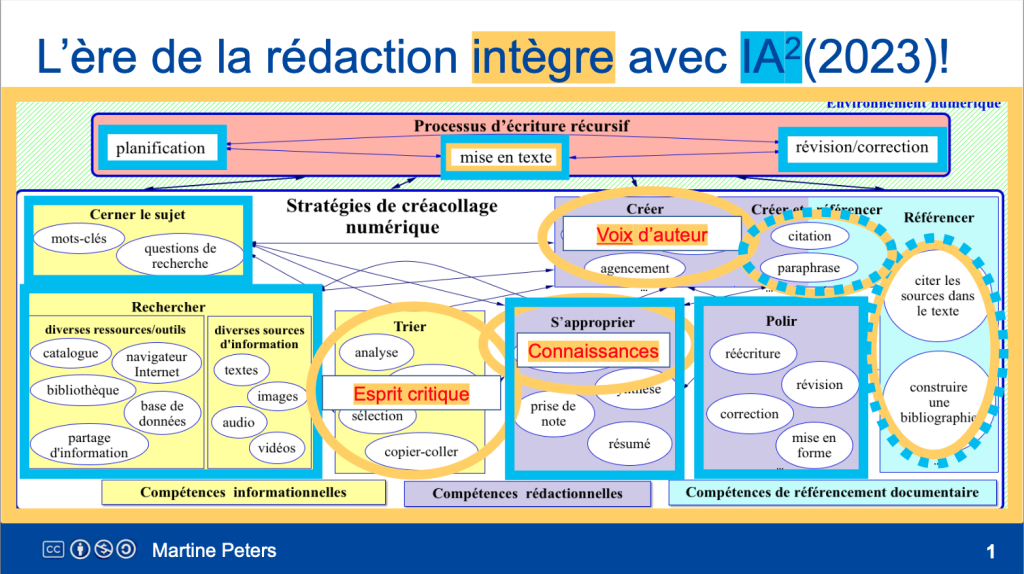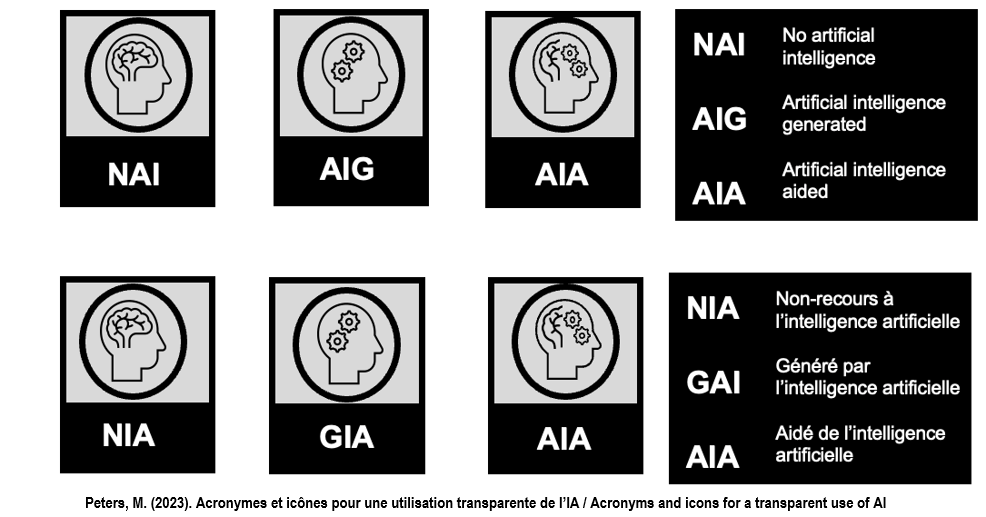Repenser l’évaluation à l’ère de l’intelligence artificielle:
l’accent sur l’intégrité académique.
IA1 et IA2
Par Martine Peters, Université du Québec en Outaouais
Atelier offert Au Cégep de la Gaspésie (Canada)
(16 janvier 2024)
20240113_Feuille_note_participantsDownload
Références
Diapositive 6 : Démonstration de ChatGPT pour l’apprentissage
- Pimido (2023). https://www.pimido.com/
Diapositive 9 : Trois informations sur l’IA2
- Mollick, E. (2023). The Best Available Human Standard. https://www.oneusefulthing.org/p/the-best-available-human-standard?utm_source=post-email-title&publication_id=1180644&post_id=137285312&utm_campaign=email-post-title&isFreemail=true&r=2fm3lf&utm_medium=email
Diapositive 9 : Intelligence artificielle
- Marr, B. (2019, November 11). 13 Mind-Blowing Things Artificial Intelligence Can Already Do Today. https://www.forbes.com/sites/bernardmarr/2019/11/11/13-mind-blowing-things-artificial-intelligence-can-already-do-today/?sh=2cbcddac6502
Diapositive 12 : Faiblesse de l’IA
- Mollick, E. (2023). One Useful Thing. https://www.oneusefulthing.org/
- Mollick, E. (2023). https://substack.com/@oneusefulthing
Diapositive 16 : Définition du plagiat
- (2023). Is ChatGPT Plagiarism? No. Here’s Why We Think So. Nerd Chalk https://nerdschalk.com/is-chatgpt-plagiarism
Diapositive 19: Parlons-en de la détection…
- Clay, G. (2023). The Depth of the AI Plagiarism Problem. AutomatED: Teaching Better with Tech. https://automated.beehiiv.com/p/depth-ai-plagiarism-problem
Diapositive 27 : Nouvelle façon d’écrire ❤️
- Eaton, S. E. (2023). 6 Tenets of Postplagiarism: Writing in the Age of Artificial Intelligence. Learning, Teaching and Leadership: A blog for educators, researchers and other thinkers by Sarah Elaine Eaton, Ph.D. https://drsaraheaton.wordpress.com/2023/02/25/6-tenets-of-postplagiarism-writing-in-the-age-of-artificial-intelligence/
Diapositive 30 : Pour être transparent…
- Peters, M. (2023). Acronymes et icônes pour un usage transparent de l’IA / Acronyms and icons for a transparent use of AI. http://w4.uqo.ca/mpeters/ateliers-workshops/
Diapositives 33 : L’ère de la rédaction préhistorique (2021)!
- Peters, M. (2021). Demande de subvention de partenariat soumise au CRSH. http://w4.uqo.ca/mpeters/ateliers-workshops/
Diapositives 34 : L’ère de la rédaction intègre avec IA2 (2023)!
- Peters, M. (2023). L’ère de la rédaction intègre avec l’intelligence artificielle, modèle 2023 : http://w4.uqo.ca/mpeters/ateliers-workshops/
Diapositive 35: L’ère de la rédaction intègre avec IA2 (2023)!
- Cursus (2023). Exemples de prompts ChatGPT pour créer des exercices interactifs en un rien de temps (+vidéo). https://cursus.edu/fr/27692/exemples-de-prompts-chatgpt-pour-creer-des-exercices-interactifs-en-un-rien-de-temps-video?fbclid=IwAR2xEUc4DXdLrUsfrxFOKCBb-LfO9vIambCw_x_OCmmv6Tn77DBN6-bTGBI
Diapositive 36 : Les six chapeaux appliqués à l’IA2 ❤️
- Mind Tools Content Team. (2023). Six Thinking Hats ®. https://www.mindtools.com/ajlpp1e/six-thinking-hats
- Jin, T. (2023). Leveraging the strengths of LLMs for creativity and thinking. Medium. https://uxdesign.cc/leverage-the-strengths-of-llms-for-creativity-thinking-58137a8da8b9
Diapositive 37 : Chat GPT Cheat Sheet
- Schwarz, C. (2023). https://www.facebook.com/photo.php?fbid=10219009538984455&id=1684067571&set=gm.1330962817844170
Diapositive 38 : Comment formuler des requêtes ?
- École Branchée. (2023). L’art du « Prompt » : Guide 101 pour les personnes enseignantes. https://ecolebranchee.com/lart-du-prompt-guide-101-pour-les-personnes-enseignantes/
Diapositive 39 : L’ère de la rédaction intègre avec IA2 (2023)!
- Consensus (2023). https://consensus.app/search/ ❤️
Diapositives 40-41 : L’ère de la rédaction intègre avec IA2 (2023)!
- Research Rabbit. (2023). https://www.researchrabbit.ai/
- https://researchrabbitapp.com/home
Diapositives 42-44 : Pour développer l’esprit critique…
- Optic AI or Not (2023). https://aiornot.optic.xyz
- CQ-ÉMI. (2023). Les formations du CQÉMI et de son réseau partenaire. https://www.cqemi.org/fr/formations ❤️
- Agence Science-Presse. (2023). Nos ateliers de formations. ($$) https://www.sciencepresse.qc.ca/nos-ateliers-formation
Diapositives 45-47 : L’ère de la rédaction intègre avec IA2 (2023)!
- Quillbot (2023). https://quillbot.com/?utm_medium=paid_search&utm_source=google&utm_campaign=paraphrase_premium&campaign_type=performance_max&gclid=CjwKCAjw1MajBhAcEiwAagW9MamBcz5rm-eBdl1DAGny2g7OfYPjJEhzfp4kiQRLMloCBwZvnURuwRoCLKoQAvD_BwE
- Chat with any PDF (2023). https://www.chatpdf.com/
- Dias, T. (2023). These Word & Google Docs Settings May Protect You From ChatGPT Plagiarism Allegations. Slash Gear. https://www.slashgear.com/1290480/microsoft-word-google-docs-setting-chatgpt-plagiarism/
Diapositive 49 : Template Classroom AI Use
- Miller, M. (2023). Template Classroom AI Use: What’s Cheating? What’s OK? https://ditchthattextbook.com/ai-cheating/
Diapositive 50 : Acceptable ou pas?
- Duguay, S. (2023). C’est le temps de repenser les notions de « Plagiat » et de « Triche ». Traduction de l’original « It’s Time to Rethink “Plagiarism” and “Cheating” de Matt Miller (DitchThatTextbook.com) https://ditchthattextbook.com/ai/#tve-jump-18606008967
- Collaboration spéciale (2023). L’IA à l’école : qu’est-ce qui est de la triche, qu’est-ce qui est correct? École Branchée. https://ecolebranchee.com/ia-en-classe-qu-est-ce-qui-est-de-la-triche-qu-est-ce-qui-est-correct/?mc_cid=b80d5f0984&mc_eid=012c4053c0
Diapositive 51 : Lecture pour vos étudiants ou pour vous ❤️
- Hew, N. (2023). How to use ChatGPT in your assignments without getting accused of plagiarism. Study International. https://www.studyinternational.com/news/chatgpt-and-plagiarism/
Diapositive 53 : Pour les étudiants
- Long, L. (2023). Acknowledging and Citing Generative AI in Academic Work. Idaho Open Press, Write What Matters. https://idaho.pressbooks.pub/write/chapter/citing-generative-ai-in-academic-work/?fbclid=IwAR1tgfgk0B1RPzlnHeLck3UgWX-VaHGlzf3LPNjLgqF7zggilvN5rSJhOU0
Diapositive 55 : Période de deuil
- Crisci, J. (2023). An important note for anyone doing AI PD for teachers. [LinkedIn]. https://www.linkedin.com/posts/jerrycrisci_an-important-note-for-anyone-doing-ai-pd-activity-7128070990684717056-V47e?utm_source=share&utm_medium=member_desktop
Diapositive 56 : Redéfinir l’évaluation
- Lodge, Howard and Broadbent (2023). Assessment redesigne for generative AI: A taxonomy of options and their viability. LinkedIn. https://www.linkedin.com/pulse/assessment-redesign-generative-ai-taxonomy-options-viability-lodge/?fbclid=IwAR2IGAAocNIMWoj9AIyBWQLiEIaJP12-9UQCaLQrH7wGp6ugTcfvUGCuE7Y
Diapositive 58 : Classe inversée
- Roy, N. (2014). La classe inversée : une pédagogie renversante? Le Tableau, 2014, Volume 3, No. 1. Direction du soutien à l’enseignement et des bibliothèques (DSEB) en collaboration avec le Groupe d’intervention et d’innovation pédagogique (GRIIP). https://pedagogie.uquebec.ca/le-tableau/la-classe-inversee-une-pedagogie-renversante
- Version PDF en ligne : https://pedagogie.uquebec.ca/sites/default/files/documents/numeros-tableau/letableau-v3-n1_2014b_1.pdf
Diapositive 60 : Atelier individuel sur la paraphrase
- Rahul Bhagat, Eduard Hovy; What Is a Paraphrase? Computational Linguistics 2013; 39 (3): 463–472. doi: https://doi.org/10.1162/COLI_a_00166
Diapositive 66 : Tâches impossibles pour les IA2 (en ce moment 11-2023)
- Mialon, G., Fourrier, C., Swift, C., Wolf, T., LeCun, Y. & Scialom, T. (2023). GAIA: a Benchmark for General AI Assistants. https://arxiv.org/pdf/2311.12983.pdf
Diapositives 68-73 : Les cinq choix de Leon Furze
- Furze, L. (2023, October 04). Rethinking Assessment for Generative AI: Beyon the Essay. LeonFurze.com. https://leonfurze.com/2023/10/04/rethinking-assessment-for-generative-ai-beyond-the-essay/?fbclid=IwAR2AovmNzhN94MJlxPSkffge-Hh58PALY-q2wcedRu5uJZnSLO20JPytGTQ
- Furze, L. (2023). AI Assessment Where Does your Assessment Sit on the Scale? https://leonfurze.com/wp-content/uploads/2023/04/scalePDF.pdf
Diapositive 74 : Activité de génération totale
- Johnston, J. (2023). AI Assignment Flip – 10 Examples. from https://www.linkedin.com/pulse/ai-assignment-flip-10-examples-jason-johnston/.
Diapositives 75-76 : Modèle d’évaluation proposée
- Peters, M., Smith, J. et Angelov, D. (2023). Planification d’une tâche évaluative qui favorise la créativité et l’intégrité académique. http://w4.uqo.ca/mpeters/ateliers-workshops
Diapositives 77-79 : Taxonomie de Bloom révisée / Objectifs et IA2
- Anderson, L.W., Krathwohl, D.R., Airasian, P.W., Cruikshank, K.A., Mayer, R.E., Pintrich, P.R., Raths, J., & Wittrock, M.C. (2001). A taxonomy for learning, teaching, and assessing: A revision of Bloom’s Taxonomy of Educational Objectives (Complete edition). New York: Longman.
- Prof Innovant. (2023). Taxonomie de Bloom révisée : verbes d’action. https://www.profinnovant.com/taxonomie-de-bloom-revisee-verbes-daction/
- Oregon State University. (2023). Advancing Meaningful Learning in the Age of AI: Bloom’s Taxonomy Revisited. https://ecampus.oregonstate.edu/faculty/artificial-intelligence-tools/meaningful-learning/?fbclid=IwAR3nzsEV0-BTPXTRdgAW6EqcbyL3pWx-LmNfH88fVjew-hZLEMe3-z5Wn1Y
- Stasse, S. (2023). Bloom revisité à la sauce IA. Cadre https://www.cadre21.org/pedagogie/bloom-revisite-a-la-sauce-ia/?fbclid=IwAR1YeXLZLby3u3OWeVArzQUYp2UKWlTgXzLJE9j94PZOYBvdKV6FDoSPhDE
Diapositives 80-81 : Compétences fondamentales ou non…
- Sidorkin, A. S. (2023, December 20). AI Pedagogy, the Introduction. AI-EDU. https://aiczar.blogspot.com/2023/12/ai-pedagogy-introduction.html?fbclid=IwAR2xNsIp8_dtp8vUHTPc7XAOcEaRj3gWW69R3L2fBNeoqrtreWft50v7UcE
Diapositive 83 : Taxonomie de Bloom révisée / Objectifs et IA2
- Anderson, L.W., Krathwohl, D.R., Airasian, P.W., Cruikshank, K.A., Mayer, R.E., Pintrich, P.R., Raths, J., & Wittrock, M.C. (2001). A taxonomy for learning, teaching, and assessing: A revision of Bloom’s Taxonomy of Educational Objectives (Complete edition). New York: Longman.
Diapositive 84 : Le délestage cognitif
- Risko EF, Gilbert SJ. (2016). Cognitive offloading. Trends in Cognitive Sciences. 20(9):676–688. doi: 10.1016/j.tics.2016.07.002.
Diapositive 85 : Le délestage cognitif, l’évaluation et l’IA
- Dawson, P. (2020). Cognitive Offloading and Assessment. In: Bearman, M., Dawson, P., Ajjawi, R., Tai, J., Boud, D. (eds) Re-imagining University Assessment in a Digital World. The Enabling Power of Assessment, vol 7. Springer, Cham. https://doi.org/10.1007/978-3-030-41956-1_4 ❤️
Diapositive 86-87 : L’évaluation authentique❤️
- Furze, L. (2023, October 04). Rethinking Assessment for Generative AI: Beyon the Essay. com. https://leonfurze.com/2023/10/04/rethinking-assessment-for-generative-ai-beyond-the-essay/?fbclid=IwAR2AovmNzhN94MJlxPSkffge-Hh58PALY-q2wcedRu5uJZnSLO20JPytGTQ
- Frey, B. B., Schmitt, V. L., & Allen, J. P. (2012). Defining authentic classroom assessment. Practical Assessment, Research & Evaluation, 17(2).
- Kashani-Vahid, L., Afrooz, G., Shokoohi-Yekta, M., Kharrazi, K., & Ghobari, B. (2017). Can a creative interpersonal problem solving program improve creative thinking in gifted elementary students? Thinking Skills and Creativity, 24, 175-185.
- Wadaani, M. R. (2015). Teaching for Creativity as Human Development toward Self-Actualization: The Essence of Authentic Learning and Optimal Growth for All Students.Creative Education, 6,669-679.
- Wiggins, G. (2011). A true test: toward more authentic and equitable assessment. Phi Delta Kappan, 92(7), 81–93.
Diapositive 88 : Caractéristiques d’une activité d’évaluation authentique intègre
- Spiller, D. (2014). Assessment matters: Academic Integrity. The University of Waikato. https://www.waikato.ac.nz/__data/assets/pdf_file/0006/352869/Assessment-Matters_-Group-Work-Assessment.pdf
- Fahim, S. (n.d.). Assessments – Prevention Strategies to Combat Plagiarism [PowerPoint presentation]. The British University in Egypt. https://www.bue.edu.eg/powerpoints-academic-honesty/
Diapositive 91-92 : Le débat ❤️
- Bauschard, S. (2023, November 05). Debating in the World of AI. Stefan Bauschard. Education Disrupted: Teaching and Learning in An AI World. https://stefanbauschard.substack.com/p/debating-in-the-world-of-ai?utm_source=post-email-title&publication_id=1673728&post_id=138620336&utm_campaign=email-post-title&isFreemail=true&r=2fm3lf&utm_medium=email
Diapositive 94 : Seth’s Ideas on the Manual… ou les consignes
- Godin, S. (2023). Thoughts on the Manual. Seth’s Blog. https://seths.blog/2023/09/thoughts-on-the-manual/
Diapositive 95-96 : Consignes
- Smith, C. D., Worsfold, K., Davies, L., Fisher, R. et McPhail, R. (2013). Assessment literacy and student learning: the case for explicitly developing students ‘assessment literacy’. Assessment & Evaluation in Higher Education, 38(1), 44-60. doi: 10.1080/02602938.2011.598636
- Harris, Robert (2015). Antiplagiarism Strategies for Research Papers. Virtual Salt. http://www.virtualsalt.com/antiplag.htm ❤️
- Cullen, C. (2020). Syllabi Designed with Integrity In Mind. Sur le site web https://www.academicintegrity.org/integrity/syllabi-designed-with-integrity-in-mind/
Diapositive 97 : Consignes pour l’intégrité
- Hough, D. (2023). Examples of Using AI to Support Student Learning & Assessment in Life Sciences. https://sway.cloud.microsoft/iNhP49DMrhOep2Uc
- Adaptation of Hough, D. (2023). Student Guidance for the Responsible Use of AI”. University of Glasgow. Edited by Rachel Heyes. #ALTc blog, October 10. https://altc.alt.ac.uk/blog/2023/10/student-guidance-for-the-responsible-use-of-ai/#gref
- Dumin, L. (2024). Annotated PDFs Assignment Information. https://ucok-my.sharepoint.com/:w:/g/personal/ldumin_uco_edu/EUqI8bd0451PuBfymuea1DYBuamYV-rl4vx7k4hFr6_Qmg?rtime=pxeeQfkV3Eg
Diapositive 95-96 : Consignes
- Spannagel, C. (2023). Rules for Tools. Pädagogische Hochschule Heidelberg. https://csp.uber.space/phhd/rulesfortools.pdf ❤️
- Dawson, P. (2023). Defending Assessment Security in a Digital World. Centre for Research in Assessment and Digital Learning (CRADLE), Deakin University, Melbourne, Australia. https://tlu.cit.ie/contentFiles/files/Cheating%2C_assessment_design_and_assessment_security.pdf
Diapositive 105 : Critères d’évaluation
- Davies, D., Jindal-Snape, D., Collier, C., Digby, R., Hay, P., & Howe, A. (2013). Creative learning environments in education–a systematic literature review. Thinking Skills and Creativity, 8, 80–91.
- Shin et al. (2012) White M, Kern ML. Positive education: Learning and teaching for wellbeing and academic mastery. International Journal of Wellbeing. 2018;8(1):1-17. DOI: 10.5502/ijw.v8i1.588
- De Bruijn-Smolders, M., Timmers, C. F., Gawke, J. C. L., Schoonman, W., & Born, M. P. (2016). Effective self-regulatory processes in higher education: research findings and future directions. a systematic review. Studies in Higher Education, 41(1), 139–158.
Diapositives 107-108 : Critères pour l’écriture avec IA2
- Sidorkin, A. S. (2023). Assessing Writing with AI. AI Czar’s Codex. https://sidorkin.blogspot.com/2023/11/assessing-writing-with-ai.html?fbclid=IwAR1UCNe73s1zLs3SrTRyK5gt6Z3TEjxq3o3M41dVHXwwijPfA-jLwW84Cpo
Diapositive 110 : Conclusion
- Shashwat. (2023). Is ChatGPT Plagiarism? No. Here’s Why We Think So. Nerd Chalk https://nerdschalk.com/is-chatgpt-plagiarism
Modèles en français

Modèle sur les stratégies de créacollage numérique avec intelligence artificielle
(Peters, 2023)

Modèle de planification d’une tâche évaluative qui favorise la créativité et l’intégrité académique (Peters, Smith, Angelov, mars 2023)

Acronymes et icône pour une utilisation transparente de l’IA
Acronyms and Icons for a Transparent Use of AI (Peters, 2023)

